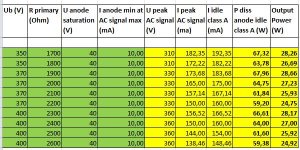After some thinking how to proceed today I have done a comparison test with 3 different G2 configs, all with Raa=4K and Ik idle =40mA. I didnt go lower with Raa because I don't want to kill my tubes, especially the screens. If somebody else wants to test it with Raa=3K5, fine with me. All 3 configs are driven at the border of clipping.
case 1: Ub connection 800V, Ug2 connection 600V, Rg2=153 Ohm (1K//180Ohm)
case 2: Ub connection 800V, Ug2 connection 600V, Rg2=1K
case 3: Ub connection 800V, Ug2 connection 400V Rg2=1K
Attached are the 3 scope pictures, scaling and configuration are the same as in the first scope picture above.
We can see that the minimum plate voltage in all cases is about 80V. From my observation this behaviour will not change if we go to Raa=3K5.
To reach this minimum plate voltage we need at G1
case 1: -7V (AB1)
case 2: -3V (AB1)
case 3: +10V (AB2)
I personally prefer case 3 as it is much more safe regarding G2.
Attached you will find the screenshots of the analyser program for case 1 and case 3. I have calculated the THD up to K11, for case 1 its 1,4%, for case 3 its 1,5%.
Thats all for today.
case 1: Ub connection 800V, Ug2 connection 600V, Rg2=153 Ohm (1K//180Ohm)
case 2: Ub connection 800V, Ug2 connection 600V, Rg2=1K
case 3: Ub connection 800V, Ug2 connection 400V Rg2=1K
Attached are the 3 scope pictures, scaling and configuration are the same as in the first scope picture above.
We can see that the minimum plate voltage in all cases is about 80V. From my observation this behaviour will not change if we go to Raa=3K5.
To reach this minimum plate voltage we need at G1
case 1: -7V (AB1)
case 2: -3V (AB1)
case 3: +10V (AB2)
I personally prefer case 3 as it is much more safe regarding G2.
Attached you will find the screenshots of the analyser program for case 1 and case 3. I have calculated the THD up to K11, for case 1 its 1,4%, for case 3 its 1,5%.
Thats all for today.
Attachments
-
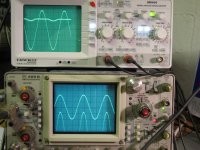 KT150 PP Ub 800 Ug2 600 Raa 4K Rg2 153 Ohm small.jpg694.4 KB · Views: 1,404
KT150 PP Ub 800 Ug2 600 Raa 4K Rg2 153 Ohm small.jpg694.4 KB · Views: 1,404 -
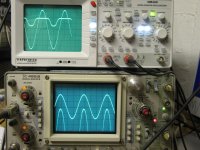 KT150 PP Ub 800 Ug2 600 Raa 4K Rg2 1K small.jpg769.7 KB · Views: 1,347
KT150 PP Ub 800 Ug2 600 Raa 4K Rg2 1K small.jpg769.7 KB · Views: 1,347 -
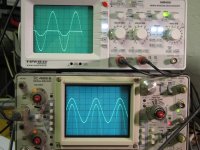 KT150 PP Ub 800 Ug2 400 Raa 4K Rg2 1K small.jpg773.5 KB · Views: 1,312
KT150 PP Ub 800 Ug2 400 Raa 4K Rg2 1K small.jpg773.5 KB · Views: 1,312 -
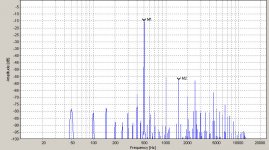 KT150 Ub800 Ug2 600 Rg 153 Raa 4K Uls RL 4_plot.jpg114.1 KB · Views: 1,302
KT150 Ub800 Ug2 600 Rg 153 Raa 4K Uls RL 4_plot.jpg114.1 KB · Views: 1,302 -
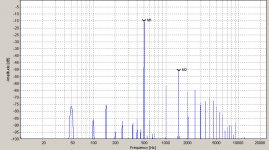 KT150 Ub800 Ug2 400 Rg 1k Raa 4K Uls RL 4_plot.jpg109.8 KB · Views: 1,279
KT150 Ub800 Ug2 400 Rg 1k Raa 4K Uls RL 4_plot.jpg109.8 KB · Views: 1,279
Again, thanks for taking the time to test the limit of the tube. It appears that case 1 not only has lower THD than case 3, its 3HD is also a lot lower, so it may suggest that there are additional distortion generated with AB2 operation - the driver may be or could just be the tube... Anyway, with music instead of continuous sine-wave, case 1 may still be ok. Of course, I doubt anyone would build an amp this way without any safety margin... I still like your GU-50 design, lower cost and much more robust.
Again, thanks for taking the time to test the limit of the tube. It appears that case 1 not only has lower THD than case 3, its 3HD is also a lot lower, so it may suggest that there are additional distortion generated with AB2 operation - the driver may be or could just be the tube... Anyway, with music instead of continuous sine-wave, case 1 may still be ok. Of course, I doubt anyone would build an amp this way without any safety margin... I still like your GU-50 design, lower cost and much more robust.
You're welcome!
It was just fun for me to test this tube. I have another Bass Amp with KT120 running 150W, one reason to start the test. One comment about powerstage in HIFI and Bassamp: Regarding frequency response and THD they are closely related.
I share your observation and comment about THD at AB2 operation. One root cause might be the change in operation of G1 when crossing from AB1 (G1 negative) to to AB2 with grid current.
I will do second test with SE config. I don't have so much experience in that area but lets see. It will take some weeks to create the bench.
Regarding GU50 (or FL152): personally its my first choice regarding reliabilty and stability ... and price.
Thanks for the tests and the info. Very nice. I got to hear a pair of these running single ended with a regulated screen supply yesterday. They seemed to sound fine, but where not near their limits at all. The owner said he likes them better than the KT120 because the 120 clips hard, as opposed to the 150 which clips softer. I did not get a chance to measure this.
hello Hans
Brilliant job.
Did you say that you kept the 4ohms jacks? Whateve was the resistance compination ?
In that case , the Raa calculation in the Excel file seems to be wrong.
if you plus 8 ohms on a the 4ohms socket of the OT, then your OT shows 8K Raa to the Power tubes.
Very good job indeed.
Forget about my Post, i did read wrong
Brilliant job.
Did you say that you kept the 4ohms jacks? Whateve was the resistance compination ?
In that case , the Raa calculation in the Excel file seems to be wrong.
if you plus 8 ohms on a the 4ohms socket of the OT, then your OT shows 8K Raa to the Power tubes.
Very good job indeed.
Forget about my Post, i did read wrong
Myles Rose (ex-GT) posted some interesting "long-term" test data on the KT150. He does not think there is much advantage of the KT150 over the KT88 (neither would KT120 I guess)... and the failure right out of the box is definitely a concen, buuut these big bottles just look too good not to put them in the amp...
An interesting point he made was that the KT150 behaves more like the 6550, not the KT88. Could some one confirm this?!
An interesting point he made was that the KT150 behaves more like the 6550, not the KT88. Could some one confirm this?!
Last edited:
Myles Rose (ex-GT) posted some interesting "long-term" test data on the KT150. He does not think there is much advantage of the KT150 over the KT88 (neither would KT120 I guess)... and the failure right out of the box is definitely a concen, buuut these big bottles just look too good not to put them in the amp...
An interesting point he made was that the KT150 behaves more like the 6550, not the KT88. Could some one confirm this?!
I've been running these tubes in several amps with none of the results in that article. The author put up test results that confirmed factory specs then went on to dis the design and performance?? The take away from the article for me was the author didn't like those tubes for some reason not associated with sound nor performance? I didn't get the point at all. I've had no reliability problems with this tube at all and I've traveled with them over 1200 miles this summer, sent them in the mail across the country, and ramped up the voltage to well over 500v at the plates AND run them Ultra Linear so yah I actually have the opposite results as the author of that article. Could be the author is looking at the tube from a guitar player perspective not audio which is where I use these tubes. I'd have to say I would want to see another "technical" article based on actual test results to draw any conclusion. I like the sound of these tubes and haven't had any reliability issues at all. I've driven these tubes hard, my transformers get hot and saturate before any issue with the tubes. There are not very many transformers built and readily available that go up the the max plate and max current this tube can handle or even close so I'm not sure what the point of the article was. My real world experience with this tube is not in line with that article.
Cheers,
Bob
I don't think Myles set out to write a bad review of the tube, he was just documenting what he saw in his tests. Yes, his opinion is perhaps a bit lop-sided, because the requirement for continuous high-power use in guitar and musical instrument amplifiers, and perhaps the samples he got, had QC issue or were demaged during shipping, which caused them failed right out of the box.
Myles was they guy responsible for testing, QA/QC & classifying thousands of tubes when he was at Groove Tubes, so reliability was/is always a very important factor in his mind. He is perhaps not viewing the tube from a consumer's angle...
In any case, running these tubes conservatively for hi-fi use, they would be just coasting along, so I am not surprised that you have very good experience with them, which is great to know. Anyway, it would be interesting to get es345's feedback because he may have use them in his bass amps on stage.
Myles was they guy responsible for testing, QA/QC & classifying thousands of tubes when he was at Groove Tubes, so reliability was/is always a very important factor in his mind. He is perhaps not viewing the tube from a consumer's angle...
In any case, running these tubes conservatively for hi-fi use, they would be just coasting along, so I am not surprised that you have very good experience with them, which is great to know. Anyway, it would be interesting to get es345's feedback because he may have use them in his bass amps on stage.
Myles was they guy responsible for testing, QA/QC & classifying thousands of tubes when he was at Groove Tubes, so reliability was/is always a very important factor in his mind. He is perhaps not viewing the tube from a consumer's angle...
In any case, running these tubes conservatively for hi-fi use, they would be just coasting along, so I am not surprised that you have very good experience with them, which is great to know. Anyway, it would be interesting to get es345's feedback because he may have use them in his bass amps on stage.
It could be his opinion was swayed due to the bad pair out of the box on first try, idunno. My point was that it would be very difficult (to source components) AND expensive to build an amp be it for instrument or audio that takes this tube to the limits. I don't think its realistic really. I do understand trying to verify or dis-spell factory claimed specifications 100% on that. Not real clear on weather he accomplished that or not tho...
I like the sound of these but I'm not seeing a huge uptick in KT150 tube amps being built/offered to the public so maybe there's something to it there!?
Cheers,
Bob
It is expensive to buld especially for SE, PP not so bad.My point was that it would be very difficult (to source components) AND expensive to build an amp be it for instrument or audio that takes this tube to the limits.
The KT150 is still realtively new to the market, give it some time, I think we will see more high-end, high power Class AB amps built with the KT150s.I like the sound of these but I'm not seeing a huge uptick in KT150 tube amps being built/offered to the public so maybe there's something to it there!?
Anyway, it would be interesting to get es345's feedback because he may have use them in his bass amps on stage.
Here is a short status update, thanks Jazbo8 for the reminder. First of all I haven't done too much on that during the last 6 month (prio 1 project was the refurbishment of my home). During the last tests I have done with the KT150 I have recognized that the tube does not like working at the specification limits. After some hours testing at the limit the tubes started to reduce the cathode emission. Due to that fact for myself I have decided not to use them in a bass amp. I will continue with GU50 for that job, extremely reliable up to the spec limits and even a little above.
What I will do is to build up a SE guitar amp with the KT150. This is just for my personal curiosity. PT,Choke, OT are already waiting, but it will take some time to build. I will keep you informed.
for the price, i wouldn't be too excited about these kt-150's...
+1 KT120 seem to be better value and quite well liked....
So, could someone give me an idea of what I might be able to get out of a KT-150 in a single-ended guitar amp application? My current project is using a KT-120 into a 2.5k load with 366V on the plate and 300 on G2, fixed bias, and I'm shooting for 22W. Would it be reasonable to shoot for 30 or maybe 35W with a KT150?
Thanks,
Joe
Thanks,
Joe
There is not too much detailed data available about the KT150. Based on my measurements it is an "extended" KT120. Here is a quick an dirty excel to roughly estimate the range of output power of a Class A SE. Input is Ub(V), Ra primary(Ohm), lowest voltage (V) of the anode when starting clipping and the remaining anode current (mA) at the positive AC signal peak. The calculation is based on a pure sine wave ignoring all nonlinearities. The output is the estimated output power, the resulting class A anode current and the anode power dissipation based on that current.
I have put in some configs.
Hans- Georg
I have put in some configs.
Hans- Georg
Attachments
I agree with the "extended" KT120 description, but I doubt it could swing as low as 40V in a real amp, so the output power is likely to be lower than those shown by es345. Other than its distinctive Gerkin look, a KT120 or even a KT88 would probably make more sense in a SE guitar amp.
- Status
- This old topic is closed. If you want to reopen this topic, contact a moderator using the "Report Post" button.
- Home
- Amplifiers
- Tubes / Valves
- Comparison KT150 versus KT120
